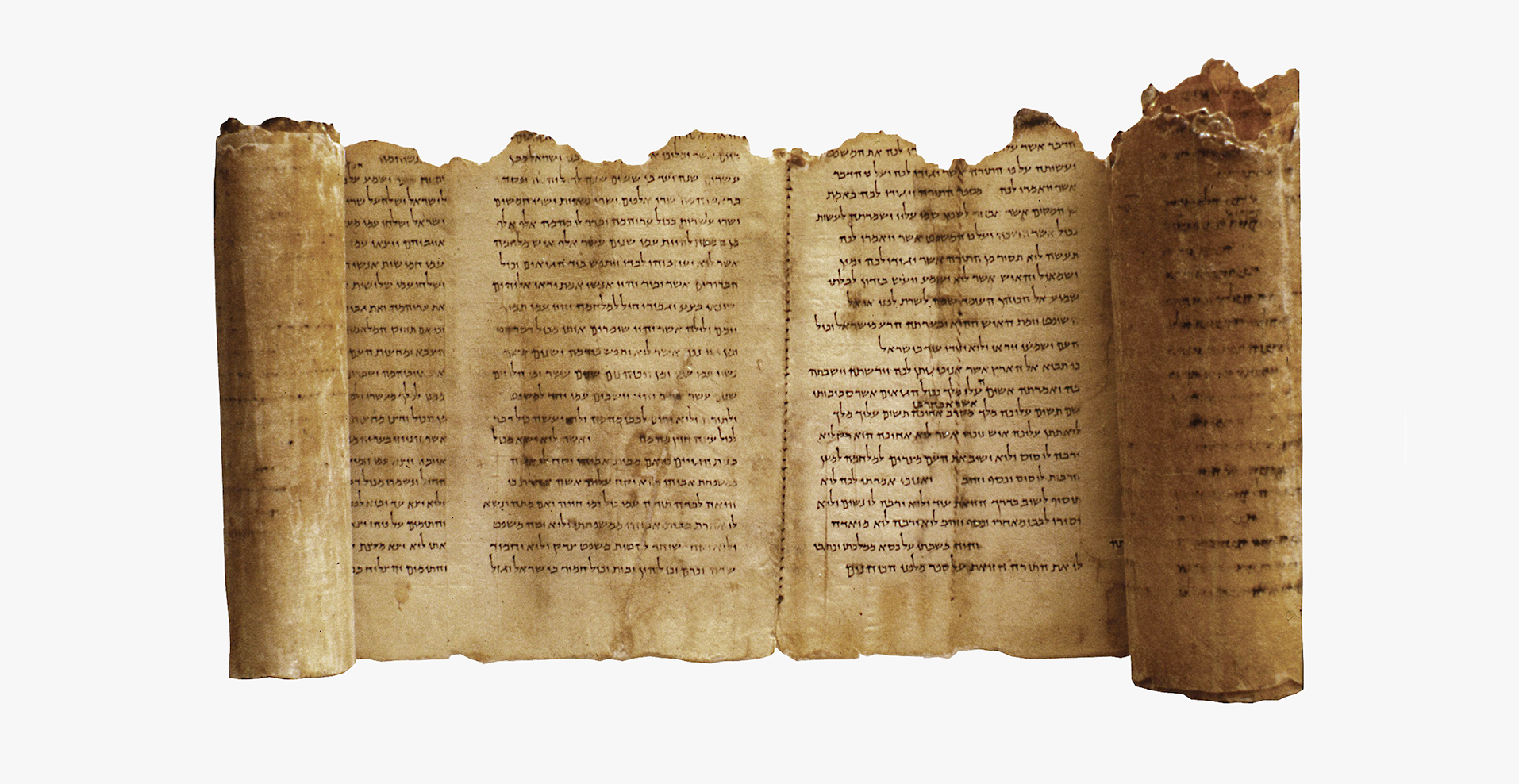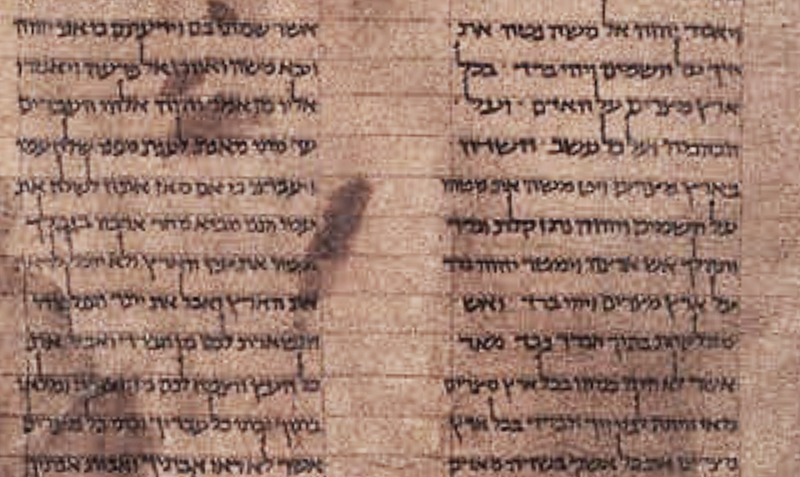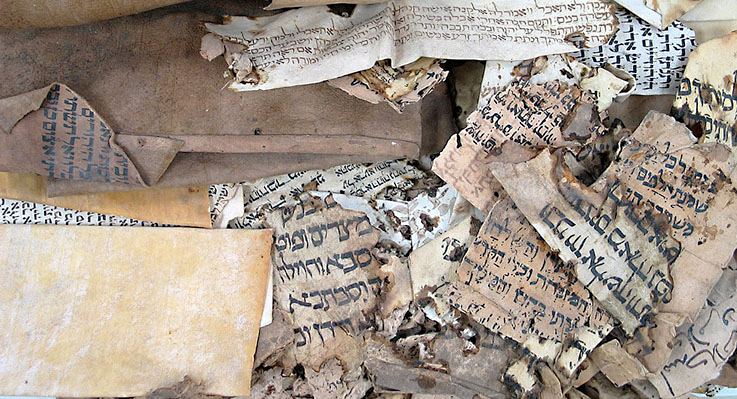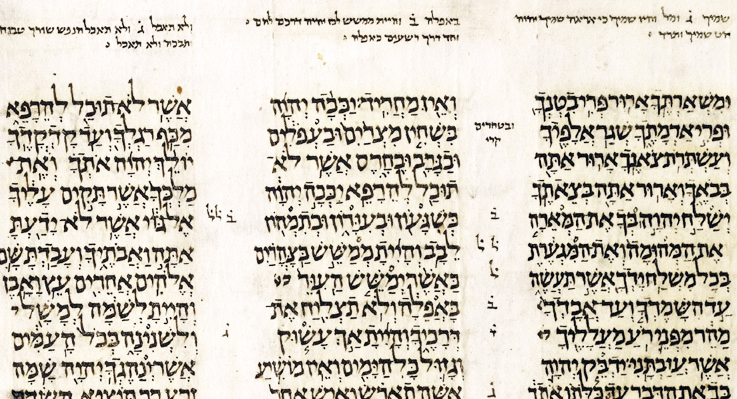
Bible, History, Archaeology
Bible,
History,
Archaeology
Manuscripts, scrolls or codices
from the Old Testament
Contents:
Intro – The two rolls of Ketef Hinnom – The Nash papyrus – The Dead Sea Scrolls – An image from the Temple Scroll – The Ashkar-Gilson and Lourdes manuscripts – The Cairensis manuscript – The Cairo Guenizah Scrolls – L'Oriental 4445 – The Aleppo codex – The Leningrad codex – The Saint Petersburg codex of the Prophets – The Torah scroll from the University of Bologna
 A codex (plural, codices) is a notebook made up of two-sided handwritten pages bound together. This ancestor of the modern book was invented in Rome in the 2nd century B.C. and spread from the 1st century A.D., gradually replacing the papyrus or parchment scroll thanks to its small size, low cost and easy access to any part of the text.
A codex (plural, codices) is a notebook made up of two-sided handwritten pages bound together. This ancestor of the modern book was invented in Rome in the 2nd century B.C. and spread from the 1st century A.D., gradually replacing the papyrus or parchment scroll thanks to its small size, low cost and easy access to any part of the text.
Image opposite: reconstruction of an ancient workshop (yeshiva) for making copies of Torah scrolls. Les secrets révélés de la Bible«. Arte TV.
 The Dead Sea Scrolls (3rd century BC to 1st century AD)
The Dead Sea Scrolls (3rd century BC to 1st century AD)
In late 1946 or early 1947, a young Bedouin shepherd nicknamed ed-Dhib («the Wolf») from the Ta'amireh clan, a tribe living on the north-western shores of the Dead Sea, fortuitously discovered some priceless manuscripts in a cave perched on the side of a hill in the Judah Desert, near the archaeological site of Khirbet Qumran, about a kilometer from the Dead Sea.
Image opposite: the Qumran plateau with the site where the scrolls were discovered. DR.
The Temple Scroll.
Ancient Hebrew manuscript from the caves of Qumran. This scroll, 8.60 m long and comprising sixty-six columns of text, has been preserved at the Israel Museum in Jerusalem since its acquisition by Yigael Yadin in 1967 © DR.
 The Ashkar-Gilson and London manuscripts
The Ashkar-Gilson and London manuscripts
(7th / 8th century AD)
Two Torah fragments clearly belonging to the same scroll. Paleographic analysis and carbon-14 results have dated these documents to around the seventh and eighth centuries. Specialists have long been aware of these extremely rare pieces that have travelled through history. They belong to different modern contexts.
Image opposite: a leaf from the Ashkar-Gilson manuscript (detail). DR.
 Codex Cairensis (9th century AD)
Codex Cairensis (9th century AD)
Also known as the Cairo Codex. It is kept in the Karaite synagogue in Cairo, Egypt, and contains the earlier and later Prophets, and for this reason is also called the Codex of the Prophets. It was copied and vocalized in 896 by the most famous of the Massorets: Moses Ben Asher.
Image opposite: reconstruction of an ancient workshop (yeshiva) for Torah and Talmud manuscripts. documentary « les secrets révélés de la Bible ». Arte TV.
 The Menizah Scrolls
The Menizah Scrolls
Cairo (6th, 7th and 8th centuries A.D.)
Around 200,000. They include many fragments of the Bible (several thousand) in Hebrew and Aramaic, as well as Arabic translations, mostly dating from the 6th, 7th and 8th centuries. They are kept at the Ben Ezra Karaite synagogue in Cairo and contain the books of the Prophets, both early and later.
Image opposite: fragments of various manuscripts from the Cairo guenizah before conservation and classification. University of Cambridge and Bodleian Libraries, University of Oxford.
Oriental 4445 (9th century AD)
Housed in the British Museum, London. Dating from around 850 AD (the vowel points were added around a century later), it contains the Pentateuch.
 The Aleppo codex (10th century AD)
The Aleppo codex (10th century AD)
It takes its name from the synagogue in Aleppo, Syria, where it was preserved. It dates from around 930 and is currently housed in the Israel National Museum in Jerusalem. It contains the entire text of the Tanakh; unfortunately, it was damaged during a pogrom in Aleppo in 1947, leaving only 295 folios of the original 491. It served as the basis for the The Hebrew University Bible.
Image opposite: a detail of the text from the Aleppo codex. Israel Museum, Jerusalem.
 The Leningrad codex
The Leningrad codex
(10th-11th century AD)
The Leningrad Codex (codex Leningradensis), dated around 1010 CE, is the oldest surviving copy of the Massoretic text of the Hebrew Bible. According to its colophon, it was written on the basis of the Aleppo Codex, written a few decades earlier, but of which some parts have been damaged or missing since 1947.
The Leningrad codex served as the basis for the Biblia hebraica in 1937 and the Biblia Hebraica Stuttgartensia in 1977, which are an almost exact transcription. It also serves as a primary source for researchers attempting to reconstruct the details of the missing part of the Aleppo codex.
Image opposite: the Leningrad Codex (Codex Leningradensis), dated 1008, is the oldest copy of the Masoretic text of the Hebrew Bible. Image © D.R.
The Saint Petersburg codex of the Prophets (9th-10th century AD)
Originally housed in a Crimean synagogue, it was discovered in 1839 by Avraham Firkowitch, a Karaite rabbi, writer and Russian archaeologist, who brought it back to St. Petersburg. The same collector is responsible for the Leningrad Codex. It contains the Last Prophets.
 The Torah scroll from the University of Bologna (12th / 13th century AD)
The Torah scroll from the University of Bologna (12th / 13th century AD)
The scroll discovered in Bologna is 36 metres long and 64 centimetres high: it contains the complete text of the first five books of the Bible - the Pentateuch (Genesis, Exodus, Leviticus, Numbers and Deuteronomy).


 The Ashkar-Gilson and London manuscripts
The Ashkar-Gilson and London manuscripts Codex Cairensis (9th century AD)
Codex Cairensis (9th century AD) The Menizah Scrolls
The Menizah Scrolls The Aleppo codex (10th century AD)
The Aleppo codex (10th century AD) The Leningrad codex
The Leningrad codex The Torah scroll from the University of Bologna (12th / 13th century AD)
The Torah scroll from the University of Bologna (12th / 13th century AD)